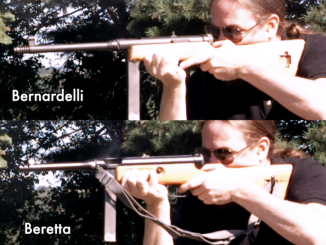Today we have one of the oldest guns we’ve looked at, a Lorenzoni repeating flintlock pistol. The system was designed by an Italian gunmaker in Florence name Michele Lorenzoni. They were made in very small numbers, and the workmanship is stunning, especially considering that they were first manufactured in the 1680s.
Instead of using a revolving cylinder pre-loaded with multiple shots, the Lorenzoni system utilizes powder and ball magazines in the frame of the gun and a rotating breechblock much like a powder throw tool used today for reloading ammunition. But the video describes it better than a written explanation:
To see more along these lines, check out the NRA Museum’s Cookson rifle, made in America in the 1750s using the same system.



Wouldn’t You need to charge the pan before firing?
Nope, it did that automatically. I didn’t think to point it out in the video, but the central cylinder has an extension that holds a slamm amount of powder for the pan. If you go to about 1:08 in the video you can see it turning.
You lucky bastard. What caliber was it?
I didn’t make a note of the caliber, but I believe it was around .50 .
Wow, never seen that before, did it also work?
Wow Ian,
You surely have unusual firearms for sore,I wonder where you get all of them??
We regularly travel to see private and museum gun collections, and so the majority of guns we have videos on aren’t our own. This Lorenzoni, for example, is probably worth more than my whole gun collection, my house, car and all my other possessions put together. 🙂
Truly awesome! I’ve been researching the Lorenzoni. I’m looking forward to seeing the video tonight after work.
Nothing really relevant to add, but that is WAY cool!
It was great to see not one but two on the trip.
I really appreciated your demonstration of the weapon’s action. There is/was a smiliar 9-shot weapon at Christie’s going for about $30,576.
See http://www.christies.com/LotFinder/lot_details.aspx?intObjectID=4833569
I discovered the reference to this pistol in a Louis L’Amour Sackett novel, “Jubal Sackett” published in 1985. Page 17 in the Bantam paperback edition describes its origin and use. L’Amour was noted for his historical accuracy so I believe it functioned as well as it was portrayed.
I’m surprised that the barrel isn’t rifled. (After all the effort the gunmaker put into this thing, you’d think he’d take that small extra step. Especially considering how this is a breechloader…)
I admire the work. How about making an exact replica and firing it? I would like to see this gun shooting.
That IS a cool bit of engineering.. Yo, I’ll give you twenny dollis right NOW for that ol’, obsolete thing!
‘Kidding!
You know, it IS strange; I’m a blackpowder enthusiast, and while I’ve seen just about every important historical piece reproduced for modern shooters, I’ve never seen this or it’s variations resurrected. I’m suprised, given that, though it was rare, it was a good, functioning design, and viable pioneering repeater .
Do you know of any one who makes kits of the Cookson flintlock rifle/Lorenzoni System?
I would love to build a rifle kit of this!
I came across an introduction to an antique repaeting flintlock made in early 18th century. It looks alike a Cookson Volitional though the lever is on the top of the action. The word “Robert Smith” is found on the gun. Photos are available. Would like to know more. Thanks.
In looking at other sites on this gun there is a concern that the gun can explode, blow of a hand. They do point out that the handle will not contain pressure before the fill cap blows off. The person that built a model using the approach added a seal to prevent any combustion gas from reaching the powder. But he had problems making this work.
As a engineer first a gap between the steel parts is a natural flame arrestor. So carbon will have to be in the gap to add fuel that maintains a flame. But a flame arrestor works with stoichiometric air–fuel mixture. The goal of a flame arrestor is to conduct the heat away from the flame front so it drops below the ignition temperature. Finally the powder after the first use is not pressing against the steel when the gun if fired. Another air gap.